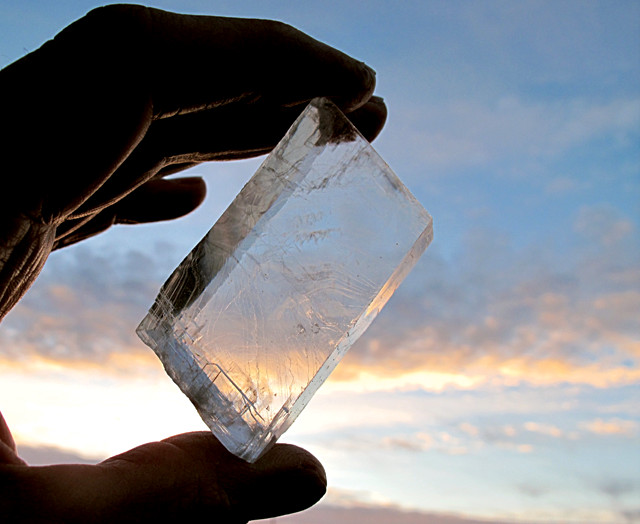
by Mary Caperton Morton Friday, August 3, 2018

A piece of Iceland spar, a type of calcite that may have been used by Vikings to navigate in cloudy conditions. Credit: ArniEin, CC BY-SA 3.0.
The Vikings ruled the North Atlantic for hundreds of years without the benefits of magnetic compasses on the rough, often stormy waters. Legends have told of Vikings using sun compasses during clear weather and “sunstones” in cloudy conditions to navigate their weeks-long journeys between ports. A new study finds that sunstones made of calcite, cordierite or tourmaline may have indeed been accurate navigational tools.
The technique, called sky-polarimetric navigation, is cumbersome, requiring a navigator to estimate the direction of skylight polarization using a sunstone and then plot the location along two celestial great circles relative to scratches made on the sunstone — all to determine the direction of north.
To study the effectiveness of sunstone navigation, Dénes Száz and Gábor Horváth of Eötvös Loránd University in Hungary ran computer simulations of 1,000 three-week-long voyages between Norway and Greenland under varying degrees of cloud cover. The simulated voyages started from the Viking-era community of Hernam (now Bergen, Norway) and followed along 60 degrees 21 minutes 55 seconds North latitude, the main route to the settlement at Hvarf in south Greenland. Sky-polarimetric navigation using different types of light-polarizing crystals has been tested in previous studies in laboratories and planetariums. But “to date, this is the most detailed and precise rating of sky-polarimetric navigation that is achievable without testing this method directly on the high seas,” the team wrote in the journal Royal Society Open Science.
The researchers found the sunstone technique to be surprisingly successful regardless of the type of crystal used for sky polarization, with voyages reaching Greenland between 92.2 and 100 percent of the time, assuming a navigator used the crystal every one, two or three hours. “We conclude that the sky-polarimetric Viking navigation [method] is surprisingly successful at spring equinox and summer solstice even in cloudy weather,” the team wrote.
© 2008-2021. All rights reserved. Any copying, redistribution or retransmission of any of the contents of this service without the expressed written permission of the American Geosciences Institute is expressly prohibited. Click here for all copyright requests.